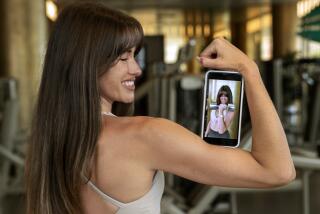Gear may work if you do
- Share via
I am interested in purchasing a piece of exercise equipment or a workout video from television, but I have heard that these products never work and that the claims they make are false.
Amy
Santa Monica
Some of these products and video programs do work, but many of them are full of impossible-to-deliver claims. Here are a few tips that will help you distinguish between the ones that are worth trying and the ones that aren’t.
Results and testimonials: Watch carefully, and you’ll usually see disclaimers on the screen that say “Results may vary” or “Results not typical.” Often, infomercials feature people who have adhered to strict diets and done much more exercise (with or without the product) than the infomercials suggest. Others may have been using the product or program for a long time and lost the weight with a variety of diet and exercise programs, not just this one product.
So don’t let the few extraordinary testimonials provide you with false hope; your own results will probably not be as significant. Real success stories most certainly came with a lot of hard work.
Weight-loss claims: Although weight-loss claims might be scientifically possible, they might not be sustainable or healthful.
For example, it is possible to lose 5 pounds in the first five days of an exercise program, but the weight might be mostly water. This amount of weight loss is unlikely to occur week after week without a risk to the exerciser -- and shouldn’t be used as a marker for determining weight loss potential. Claims such as “30 pounds in 30 days” are simply not realistic or safe.
Most exercise experts agree that only about 1 to 2 pounds of weight loss per week is safe, regardless of the exercise program or product. Besides, additional pounds are likely to be regained.
Effective exercise: Some infomercials sell products or programs designed to “isolate,” or reduce weight from, a specific area of the body, such as the abs. Although many of these products and programs do a good job of training specific body parts, there is no way to “spot reduce.” For example, a product designed to target the abs may result in weight loss (if accompanied by a reduced-calorie diet), but it may not be from around the abs. The product may make abs stronger, but the weight loss will probably come from many areas of the body (and often not the first place you want it to come from.).
Also, be mindful that larger, full-body movements generally burn more calories than smaller, isolated movements. For example, a thigh machine that makes users squeeze their thighs in a small, repetitive movement won’t burn as many calories as dancing, walking or lunges. It may be easier to do, but it won’t be as effective in burning calories as something that engages more muscles and uses bigger movements.
The hidden diet: All good fitness infomercial products will include a healthful diet and nutrition program, and much of the weight loss will be attributed to how effectively users follow this part of the program.
Of course, selling a product that requires dieting is not as interesting as a program that appears to melt the fat off users without changing their eating habits. If you are not prepared to follow a diet, you might get some health benefits from using the product, but you will probably not lose much weight.
--
Jay Blahnik, a Laguna Beach-based personal trainer and IDEA Health & Fitness Assn. spokesman, has appeared in more than 25 videos and is the author of “Full-Body Flexibility.” He can be reached at jay@jayblahnik.com.


